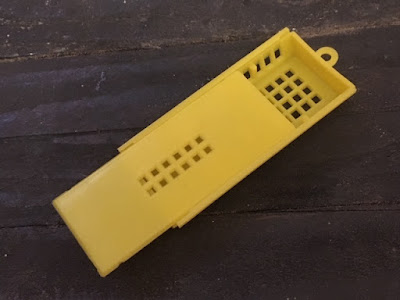Results can be improved by using a pheromone attractant, these are available commercially but if you keep bees already they can be prepared yourself: Any one that has a number of hives will have the the opportunity to evaluate the colonies and differentiate between their traits, if there are colonies that display undesirable traits, be it temper, chalk brood or just not building up as desired, or whatever, has the option to re-queen using eggs or larvae from their other colonies. This requires the removal of the old queen. These can be discarded, or more favourably, they can be used to progress your beekeeping. After dispatching the unwanted, queen she should be deposited in a bottle of alcohol or similar solvent and any other such queens should be added along with any unwanted virgin queens. The resultant tincture is the daubed onto the wood work of the bait hive. This is an excellent swarm attractant!
 |
| Queens in alcohol |
A farming family attended our branch meeting a couple of years ago, looking to have some bees on their farm. I contacted them and arranged to meet and discuss placing a number of hives there. They showed me around their farm, which was very interesting, they have robots that milk their cows on demand. If you ever get the chance to visit a similar dairy farm you should jump at the opportunity it's fascinating. We eventually chose a suitable site, surrounded on three sides by a small wood, the open side being south facing. Shortly after I placed a couple of nucs there and left them to overwinter. On my second visit I noticed that there was a wild tree colony not thirty feet from my nucs. I had chosen a site that bees had decided was an ideal site too!
 |
| Wild tree bees |
I called at the farm to inspect the nucs that I had placed there earlier last May, the farmer came out to greet me and said that the pest controller had called to deal with a mole infestation two days after my last visit and had pointed out a large swarm of bees flying over the wood where my bees were located. I was certain that any swarm was not from my nucs, they had plenty of room to grow and had newly matted queens heading them, it must be a swarm from the tree. Could they have taken the bait and moved into my hive?
Well, yes they did! There was a lot activity at the hive entrance, with bees coming and going and bringing in lots of pollen, this was a prime swarm headed by a mated queen. On inspection they had drawn out all eleven frames, there were four frames of brood and the rest was very light honey and nectar. I made a note to bring another brood box the following day to give them room to grow. I didn't take any honey from this colony but I will take some from this apiary in May this year if I can, the honey is much lighter in colour than from my existing apiaries. Instead I decided to propagate from these bees, the were very dark in colour but their abdomen banding is grey, indicating that they are Carniolan bees, not what I really want, as I am trying to breed Apis mellifera mellifera. They are however very good bees to work with, being very calm on the comb and as far as I can, tell produce a good honey crop. I will keep them separate from my queen breeding.
I used a Snelgrove board to rear queens from this swarm colony, this is the first time that I have used a Snelgrove board. I now have four daughter colonies from the swarm, two in five frame nucs and two in double five frame nucs. This is despite a ferocious attack from wasps at the end of last season, robbing out nucleus colonies. I shall write a page documenting using the Snelgrove board later this year. I found it easy to use and had very good results, they are easy to make from a crown board although I got mine from an association auction.

